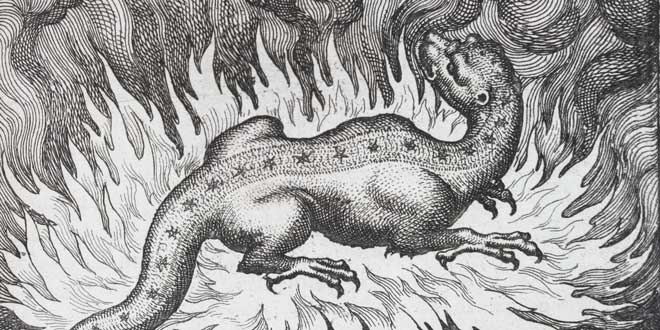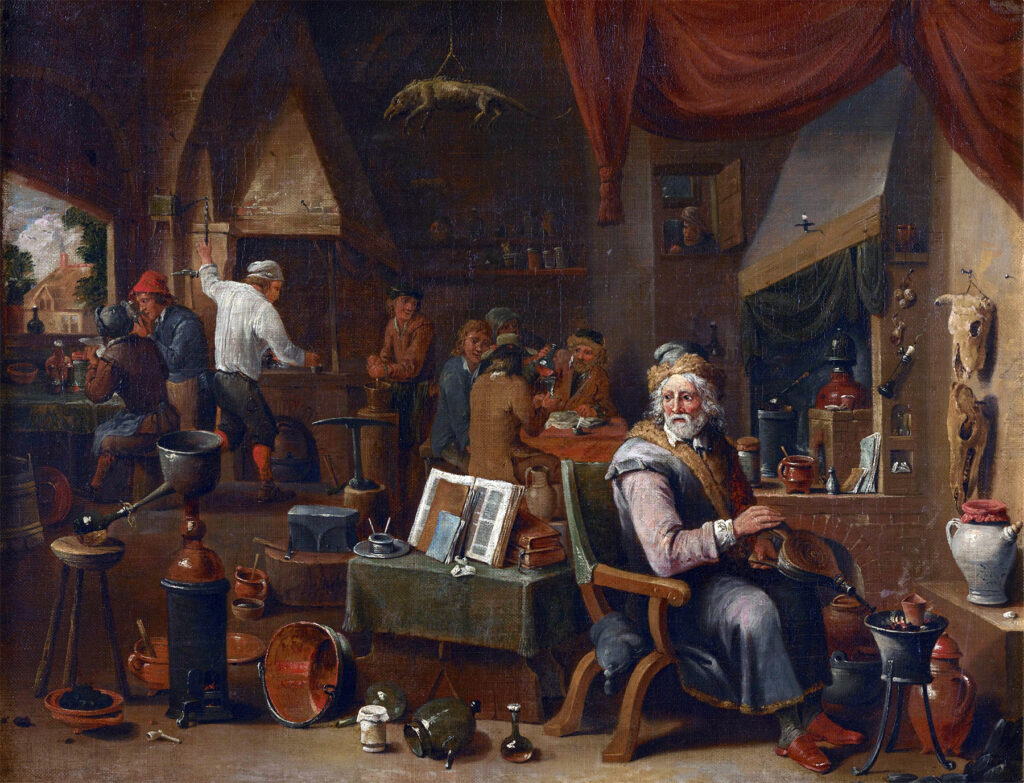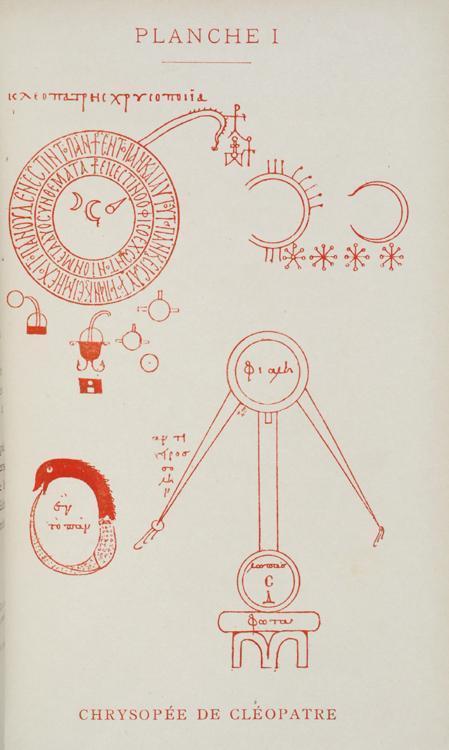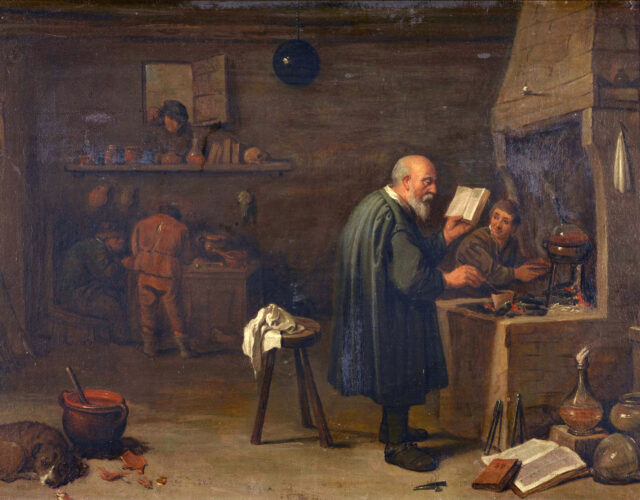Lawrence Principe is one of the foremost scholars of alchemy in the world. He earned his first PhD in chemistry and his second in the history of science. We asked him to give our readers a taste of his book The Secrets of Alchemy.
Alchemy is full of secrets. Nevertheless, over the past generation scholars have been revealing more and more of its surprising content and importance. No longer is it dismissed as a waste of time or a fool’s quest. Alchemy is now increasingly recognized as a fundamental part of the heritage of chemistry, of continuing human attempts to explore, control, and make use of the natural world. Alchemists developed practical knowledge about matter as well as sophisticated theories about its hidden nature and transformations. Their hope of discovering the secret of preparing the philosophers’ stone—a material supposedly able to transmute base metals into gold—was one powerful incentive for their endeavors. But at the same time, they contributed to mining and metallurgy, and pharmacy and medicine, and their achievements and aspirations (as well as failures) inspired artists, playwrights, and poets. Their researches and goals had both commercial and scientific aspects, as well as philosophical and theological ones. Many alchemists expressed (often just implicitly) a strong confidence in the power of human beings to imitate and improve on nature, and their work included the exploration of the relationship of human beings to God and the created universe. The work of historians of science continues to reveal the enormous complexity and diversity of alchemy, its important position in human history and culture, and its continuities with what we now call chemistry.
Much of this new understanding remains little known outside of a small circle of academic specialists. In the wider world the revolution in our knowledge of alchemy might count as one of alchemy’s biggest secrets. But the subject of alchemy remains evocative and alluring for a broad array of people; I have met many who would genuinely like to know more about it. Unfortunately, the resources currently available are rather slim. The readily available general histories of alchemy in English are all over 50 years old, and while they were excellent resources in their day, they now need updating. My goal in writing The Secrets of Alchemy was to bring the results of recent academic work to a broader public. The book surveys the history of alchemy from its origins in late antiquity to the present day. It focuses on a few representative characters and ideas from each of alchemy’s several historical epochs in the West—the Greco-Egyptian, the Arabic, the Latin medieval, the early modern, and the modern. The Secrets of Alchemy also shows how the frustratingly obscure secret language of code and metaphor routinely used by alchemists to hide their knowledge (and hopes) can be deciphered—sometimes into impressive feats of chemical experimentalism—and even replicated in a modern laboratory. The text is written for anyone interested in the story of alchemy and its remarkable practitioners and ideas. Extensive endnotes (almost a third of the book) provide a guide through the current scholarly literature on the subject for those wishing to wade further into the subject’s deep waters.
No treatment of alchemy can be exhaustive. It was too diverse a phenomenon, too widespread geographically, socially, and chronologically. While we’re learning more about the subject every day, there still remain wide gaps in our knowledge. The following excerpts provide glimpses of three alchemical practitioners who carried out their researches in widely different periods and cultures, and often for widely different purposes.

Zosimos: At Alchemy’s Foundations
(excerpted from pp. 14–17)
In the cosmopolitan crossroads of Greco-Roman Egypt, the two streams of craft traditions and philosophical traditions coexisted. Their merger—probably in the third century AD—gave rise to the independent discipline of alchemy. The intimate mingling of the two traditions is evident in the earliest substantial texts we have about chrysopoeia [gold making]. These writings come from a Greco-Egyptian alchemist who would be revered as an authority for the rest of alchemy’s history, and the first about whom we have any reasonably substantial or reliable historical details: Zosimos of Panopolis.
Zosimos was active around 300 AD. He was born in the Upper Egyptian city of Panopolis, now called Akhmim. Zosimos is thought to have written twenty-eight books about alchemy; alas, most of what he wrote is now lost. We have only scraps: the prologue to a book titled On Apparatus and Furnaces, several chapters from other works, and scattered excerpts. Some of Zosimos’s writings are addressed to Theosebeia, a woman who seems to have been his pupil in alchemical matters, although whether she was a real person or a literary device we will never know for sure. Despite the fragmentary nature of what survives and the difficulty in interpreting it, these writings provide the best window we have onto Greek alchemy. These early texts establish many concepts and styles that would remain fundamental for much of later alchemy.
Zosimos’s orientation toward a central goal (metallic transmutation), his insightful engagement with the practical problems in reaching it, his search for the means of surmounting these problems, and his formulation and application of theoretical principles clearly underscore his writings as something new. Zosimos’s texts witness a coherent program of research that draws on both material and intellectual resources. He describes a wide array of useful apparatus—for distillation, sublimation, filtration, fixation, and so forth—in great detail.
Many of these instruments are adapted from cooking utensils or items used in perfumery or other crafts. Zosimos did not devise all these instruments himself, indicating how developed practical chrysopoeia must already have become by the start of the fourth century AD. The writings of his predecessors form a key resource for him, and he cites them frequently. One of the most prominent authorities is named Maria—sometimes called Maria Judaea or Mary the Jew—and Zosimos credits her with the development of a broad range of apparatus and techniques. Maria’s techniques include a method of gentle, even heating using a bath of hot water rather than an open flame. This simple but useful invention preserved the legacy of Maria the ancient alchemist, not only for the rest of alchemy’s history, but even down to the present day. It is her name that remains attached to the bain-marie or bagno maria of French and Italian cookery.
Several of the pieces of apparatus Zosimos describes—for example, one called the kerotakis—are designed to expose one material to the vapors of another. Indeed, he seems particularly interested in the action of vapors on solids. This interest is partly grounded on practical observations. Ancient craftsmen knew that the vapors released by heated cadmia (or calamine, a zinc-containing earth) could turn copper golden by transforming it into brass (an alloy of zinc and copper). The vapors of mercury and arsenic whiten copper to a silvery color. Perhaps knowledge of these color changes induced Zosimos to seek analogous processes that would bring about true transmutations. Guiding theories are certainly discernible in his writings. Today there is a common misconception that alchemists worked more or less blindly—stumbling about mixing a little of this and a little of that in a random search for gold. This notion is far from the truth; already with Zosimos we can identify theoretical principles that guided his practical work, as well as practical observations that supported or modified his theories. Many theoretical frameworks for alchemy would develop in various times and places, and these frameworks both supported the possibility of transmutation and suggested avenues for pursuing it practically.
Across the gulf of ages, Zosimos’s observant, active, questioning mind makes itself apparent. In one passage, he notices the disparate effects of sulfur vapor on different substances, and expresses his astonishment that while the vapor is white and whitens most substances, when it is absorbed by mercury, which is itself white, the resulting composition is yellow. Always ready to criticize his contemporaries, Zosimos chides them by saying that “they should inquire into this mystery first of all.” He likewise expresses his surprise that when the vapor of sulfur turns mercury into a solid, not only does the mercury lose its volatility and become fixed (that is, nonvolatile), but the sulfur also becomes fixed and remains combined with the mercury. Zosimos’s observation is now recognized as a basic principle of chemistry: when substances react with one another, their properties are not “averaged,” as they would be in a mere mixture, but are instead completely changed. Clearly, Zosimos was a careful observer who thought deeply about what he witnessed experimentally.

John of Rupescissa: Alchemy against the Antichrist
(excerpted from pp. 63–65 and 69–70)
John of Rupescissa (or Jean de Roquetaillade) was born about 1310 in the Auvergne, in central France; he attended the University of Toulouse and then became a Franciscan friar. In doing so he was influenced by the ideas of a branch of the order known as the Spirituals, who opposed the increasing institutionalization of the Franciscan order as it grew, claiming that it had abandoned the ideals and rule of its founder, St. Francis of Assisi. The Spirituals, who saw themselves as the true followers of St. Francis, embraced radical poverty and fiercely criticized church hierarchy and the more mainstream Conventual Franciscans. The Spirituals were also caught up in apocalyptic fervor and a fondness for prophecies, believing that the Antichrist was about to appear.
It might seem incongruous that a man so fervently committed to the ideal of poverty would also devote himself to finding the secret of making gold. Yet at the start of his Book of Light, written about 1350, John states clearly why he studied chrysopoeia and why he decided to write about it.
True to his Spiritual Franciscan views, John says that the tribulation of the Antichrist is at hand, and that the church will need every form of help to withstand it; that help includes alchemy. John was not the only Franciscan who thought this way. The same concern about the coming of the Antichrist lay behind much of what Roger Bacon—also a Franciscan friar—wrote to the pope about sixty years earlier: the church will need mathematical, scientific, technological, medical, and other knowledge to resist and survive the assault of the Antichrist. We are well familiar with the use of science and technology for national security; in the case of John and Roger, we find a medieval precedent that includes alchemy as a means of ecclesiastical security.
John describes a series of sublimations of mercury with vitriol and saltpeter, followed by digestions and distillations. Despite the apparently clear directions, however, his first step will not work in a modern laboratory if followed verbatim. The sublimate “white as snow” that John describes making is undoubtedly mercuric chloride; therefore, the starting mixture must have included common salt, but this substance is not mentioned in the list of ingredients. There are two possible explanations. First, John’s saltpeter might have been quite impure and contained a large quantity of common salt. In fact, his book contains an annotation toward the end that notes how crude saltpeter ordinarily contains salt, and gives a method for purifying it by fractional crystallization. The second possibility is that John intentionally left out the crucial ingredient as a way of preserving secrecy. If this is the case, then it is significant that the end of his book includes a rather out-of-place paragraph describing the general importance of table salt, its ubiquity, its use in purifying metals, and so forth, and then states that “the whole secret is in salt.” Whichever explanation is correct, the historical message is the same: alchemical recipes have to be read with care. Those that seem unworkable need not reflect negatively on the author’s abilities or veracity, but might rather indicate a “hidden ingredient”—either something present as an unsuspected impurity or something artfully omitted.
It might seem incongruous that a man so fervently committed to the ideal of poverty would also devote himself to finding the secret of making gold.
John also wrote On the Consideration of the Fifth Essence of All Things. With it, he extended alchemy into a new area—medicine. During the Antichrist’s reign, Christians would need not only gold but also their full health. Thus, John recounts how he sought a substance that could prevent corruption and decay and thus preserve the body from illness and premature aging. He found such a substance in the distillate of wine—what he called “burning water” or “water of life,” and what we call alcohol. The Latin alchemical term for this delightful liquid—aqua vitae—lives on in the names of several liquors: the Italian acquavite, the French eau-de-vie, and the Scandinavian akvavit.
John considers this “burning water” the “fifth essence” of the wine, its quinta essentia in Latin. (Quintessence is a word still used to express the finest, purest, and most concentrated essence of a thing.) John borrows the word from Aristotelian natural philosophy, where it represents a substance different from and greater than the four elements (fire, air, water, and earth), namely, the imperishable and eternal material from which everything beyond the moon, such as the stars and planets, is made. The implication is that this terrestrial quintessence of wine is similarly impervious to decay. While this might sound outlandish, John almost certainly based his belief on empirical evidence—he notes how meat left in the open air quickly begins to rot, but when immersed in alcohol it is preserved indefinitely. He may also have noticed that while wine quickly degrades into vinegar, distilled alcohol remains unchanged. It is this stability and preservative power that John tries to turn to medicinal use.

Cyprien Théodore Tiffereau, Alchemist of the 19th Century
(excerpted from pp. 93–94)
Some 19th-century practitioners headed in new methodological directions. They continued to pursue metallic transmutation, but in new ways that often drew on contemporaneous scientific discoveries. In the mid-1850s, for example, the chemist and photographer Cyprien Théodore Tiffereau (1819–after 1898) presented a series of papers to the Academy of Sciences in Paris outlining how, while in Mexico, he had succeeded in turning silver into gold using common reagents. He maintained that the metals were actually compounds of hydrogen, nitrogen, and oxygen and were therefore interchangeable by altering the relative proportions of these components. This idea is of course analogous to the ancient Mercury-Sulfur theory of metallic composition, but it also reflects chemical debates of the time. Recent discoveries had compelled many mid-19th-century chemists to seriously reconsider the possible composite nature of the metals. Well-respected chemists who supported the compound nature of metals openly speculated that the alchemical dream of metallic transmutation might in fact soon be realized. Thus, despite their estrangement in the 18th century, alchemy and chemistry did—in some periods—reestablish intellectual contact. One journalist expressed this striking mid-19th-century rapprochement by writing in 1854 that “after having poured out so much scorn upon her, in our day chemistry is moving towards joining with alchemy.”
Examples of transmutational alchemy’s continuation after its 18th-century ‘demise’ probably form only the visible tip of the iceberg.
Under such conditions, the Academy of Sciences was more open to claims of metallic transmutation than it would have been previously. It not only invited Tiffereau to its assembly to present his results but also organized an official committee to examine his claims. Unfortunately for Tiffereau, neither he nor others could replicate his results in Paris. He returned to a quiet private life as a photographer. In 1889, however, he reemerged from obscurity, and began to give public lectures about his findings, at which he displayed the gold he had produced in Mexico. The popular press ran excited columns about this “alchemist of the nineteenth century.” In 1891, drawing on recent work in biology and microscopy, Tiffereau proposed that the transmutations he had observed in Mexico were brought about by microbial action. He ascribed the failure of his processes in Paris to the absence of the requisite airborne microorganisms that had been present in Mexico (near the precious metal deposits, where they ordinarily existed).
On the other side of the Atlantic in the 1890s, an entrepreneurial chemist and mining engineer named Stephen Emmens offered the United States Treasury a method of turning silver into gold. Independent tests were made of his method (which involved hammering Mexican silver) both in the United States and in England, but the results were not encouraging.
These examples of transmutational alchemy’s continuation after its 18th-century “demise” probably form only the visible tip of the iceberg. Archival manuscripts bear witness to many more experimenters, and undoubtedly a much larger number left no trace of their activities. When writing his history of alchemy in 1854, Louis Figuier appended an entire chapter about hopeful mid-19th-century practitioners. He noted the large number of them active in France, especially in Paris, described their ideas at length, and visited their laboratories. There remain many very serious (and some not-so-serious) investigators at work on gold making today.




